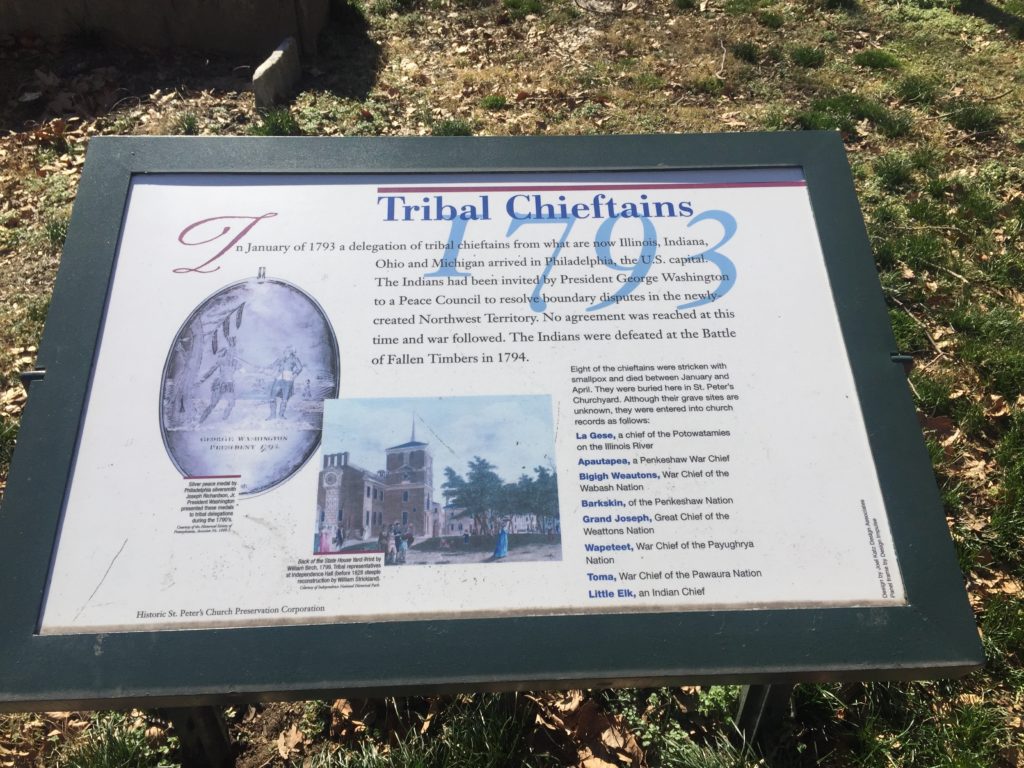Erik Visits an American Grave, Part 709
This is the sign memorializing the unmarked graves of the Native chiefs who died in Philadelphia’s yellow fever epidemic of 1793.

You can read the sign so I don’t need to repeat it. But let me just say a few words to provide some context. Yellow fever was a horrible disease in the centuries before the development of the vaccine (which I have incidentally had before I traveled around Bolivia in 2008). It was a scourge to populations in its repeated epidemics. And while we might not think of Philadelphia as a mosquito-infested swamp, it was well within the range of the mosquito which carries it. When it hit in 1793, it devastated the city. You can read a good overview of it here. There’s an argument made by historians (I cannot remember who now; there was a chapter in a reader I used to use for my survey class on this) that this also played a transformative role in the politics of the Early Republic because when rich Federalists fled the city and leading Jeffersonians did not, it demonstrated the elite politics of the former and turned voters toward the latter. Given that Pennsylvania was a swing state between the Federalist north and Jeffersonian south, one can at least plausibly argue that this epidemic had a pretty critical role in the transformation of that state and thus the nation. It’s an argument that requires a lot of connections, but it’s at least plausible.
Indian visits to Philadelphia were quite common in the 1790s. They were to meet with George Washington and other American leaders as the tribes tried to work out some way they could survive with the insatiable demands of whites. Several groups would come to Philadelphia each year. The rituals became fairly routine. Ceremonial pipes would be shared between the tribal leaders and the American political leaders. Washington would give a speech. Hamilton and Jefferson and other Cabinet members would meet with them. There would be talk, the tribes told whatever lies the government wanted to tell them, and then they would go on their way. Except in 1793 when a group from what was at that time the Northwest showed up at the wrong time and were felled by the yellow fever. A group of Chickasaws were also on their way for a similar trip to consult with the government, but heard about the epidemic along their way and wisely returned home.
And while yellow fever struck everyone equally, for Native peoples, exposure to this was one of a dozen or so horrible diseases brought over by Europeans that were continuing to decimate their populations in the late 18th century, as they would continue to do for another century. These deaths may have been an unintentional part of the genocidal project, but they certainly also served the government’s ultimate purposes.
These chiefs are buried in St. Peter’s Churchyard, Philadelphia, Pennsylvania.
This grave visit was sponsored by LGM reader contributions. Many thanks! It can be very difficult to tell the story of Native Americans in this series and so I was glad to be able to offer a little something along these lines. If you would like this series to visit other Native people, you can donate to cover the required expenses here. Red Cloud is in Pine Ridge, South Dakota and Powhatan is in King William County, Virginia. Previous posts in this series are archived here.


